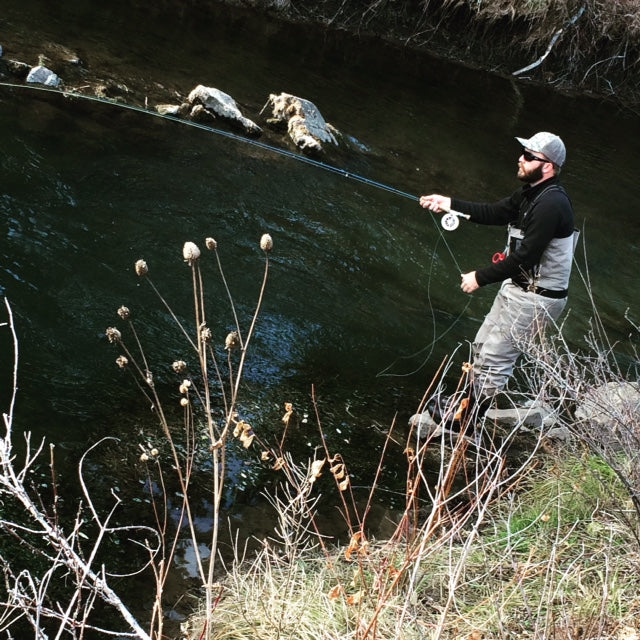Fall Streamer Tips!

Ryan Gabert |
Fall is here, and streamer fishing has been great. We have been enjoying some exceptional streamer fishing over the last week, and it should stay good throughout the winter and spring. If you're not a fish counter and dig seeing trouts smoke big flies, streamer fishing is for you! It's exciting, and gives you the chance to see fish that you might not get a chance to move fishing with nymphs. Here's a few of the things that we think are important to have streamer success!
Getting the fly in front of the fish is the first objective you have when you're streamer fishing, and sink tips are often necessary to get a bulky streamer down to the depths. Sink tip lines are great if you're often fishing the same river or section of river, but they limit you as to the places you can fish. A heavy sink tip line isn't going to fish well in a foot deep riffle, and a light sink tip won't get you down in a six foot deep trough that's moving quick. Because of this, we're big fans of the RIO Versileaders. You can buy them in lengths from 7-12 feet, and in sink rates from 1.5 to 7 inches per second. The variety allows you to cover most all situations that you're going to encounter, and they loop onto your standard floating fly line just like a tapered leader. They're inexpensive and allow you to quickly change out your sink tip to cover the water that you're fishing at the moment!
Fly patterns are often a source of confusion for many anglers new to fishing streamers. I'm more apt to believe that presentation matters more than the particular fly you're using, but the fly definitely plays a role in moving fish. We fish fairly large flies as a rule if we're out throwing streamers, and I believe that the larger fly has more moving power to get a big fish interested in chasing than a size 8 Wooly Bugger does. Generally, flies ranging from 2-5 inches are the standard, both single hook and articulated flavors. There's nothing like seeing a big brown running down your big streamer as you're pulling it across the current - it's the most exciting way to fly fish for trout in my book! Here's a link to another blog post about a few of our favorite streamers for the Black Hills. Don't be afraid to get your 6 weight out and throw some real meat in front of them - you'll be rewarded with some of the biggest fish in the creek.
On that note, if you're really interested in catching fish on streamers, leave your nymph stuff at home. Bring a box of streamers, a roll of 10 pound Maxima and a few sink tips. It's too easy to fish streamers for a half hour and then resort back to the bobber. If you commit to fishing streamers, you'll be surprised how many fish you can move!
Now you're all set up and ready to go fish streamers - but how do you fish them? We get this question a lot at the fly shop, and there really isn't just one answer for it. If I had to sum up how to streamer fish in one statement, it would be to keep your retrieves erratic. Baitfish and small trout don't swim around nice and smooth in the water - they dart and dance all over in many different directions. Because of that, keep your retrieves jerky, erratic, and always be changing them. If you're not catching fish on a fast strip, try a slow, jerky one instead. Different fish all want the fly in a different way, so don't be scared to mix up what you're doing and you'll be much more successful out on the stream.
One thing that I hear often in the shop is, "I was out streamer fishing and I was getting lots of bites, but when I lifted to set the hook it pulled the fly right out of their mouth!". When you're streamer-ing, the strip-set is the only way I've found to consistently hook fish. The basic idea of the strip set is to pull the line rather than lifting the rod to hook the fish, but it's often quite hard to do when you can see a hoss brown ready to chomp down on your fly! It takes some getting used to, but just keep stripping until you feel the whole weight of the fish, then lift your rod. By the time you lift your rod the fish should already be hooked, and you're just lifting the rod as a fish-fighting device essentially. A bonus side-effect of the strip-set is that if a fish eats it but doesn't get hooked, your fly is still in the water, right in front of the fish. If you would have lifted the rod, or 'trout set', you would pull the fly out of the water or at least a long way away from the fish. If you strip-set, the fly will still be in the vicinity of the fish, and they'll often come back for seconds!
Streamer fishing is a super exciting way to fish, and it's our favorite thing to do in the fall and winter. Jacob is editing away on a video of a great day of streamer fishing we had recently, so look for that in the near future as well!
Ryan
